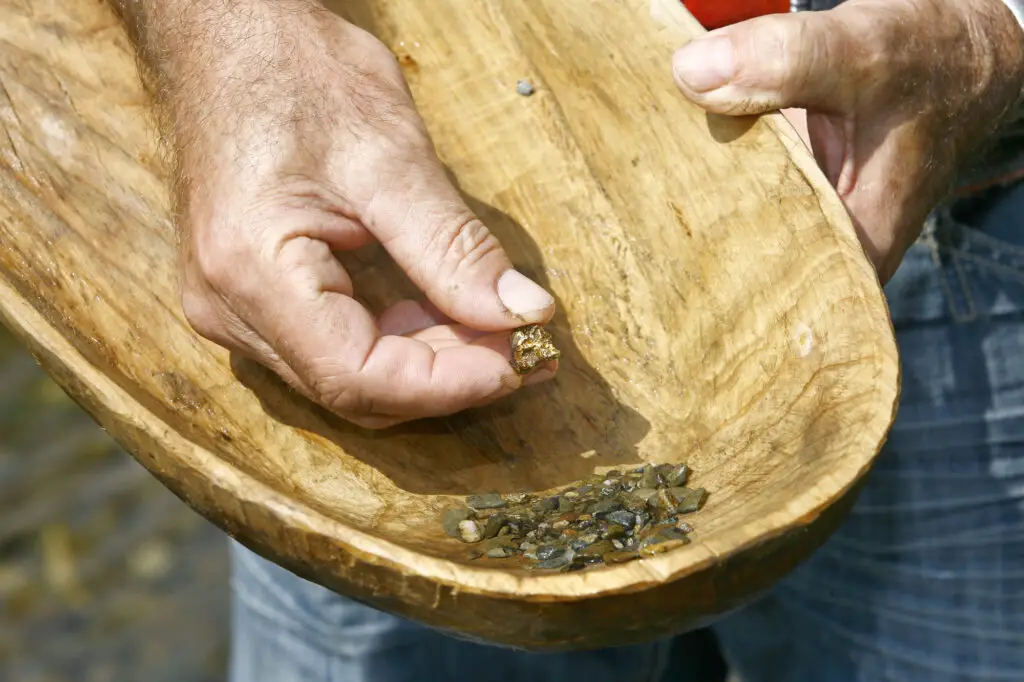In the pursuit of excitement and a touch of history, people have been drawn to the allure of gold panning for centuries. The American Southwest, and Arizona in particular, has always been a hotspot for these modern-day explorers, looking to relive the past while maybe finding a golden nugget or two.
Arizona, the ‘Copper State,’ is not only famous for its extensive copper mines but is also home to a myriad of sparkling streams and rivulets that offer some of the best spots for gold panning in the country. If you’ve ever entertained the idea of becoming a part-time prospector or you’re just keen on dipping your toes in the shimmering waters of this fascinating hobby, we’ve compiled a list of the top 30 panning spots in Arizona that will guide you to your very own gold rush!
Before you grab your panning equipment and head out, it’s important to be aware of the laws and regulations concerning gold panning in Arizona. While Arizona is quite accommodating to hobbyist gold panners, it’s crucial to respect both public lands and mining claims.
The state laws are relatively straightforward: gold panning is legal in Arizona’s national forests, public lands, and unclaimed sites. However, you need explicit permission to pan on private or claimed lands. The Bureau of Land Management (BLM) provides up-to-date maps and resources to help you navigate your prospecting adventure within the law’s bounds.
This blog post will not only provide you with the top locations to seek your fortune, but will also shed light on the rules and regulations that govern gold panning in Arizona. The locations have been carefully selected to offer a mix of easily accessible spots, remote destinations for the adventurous, and historically rich sites where gold panning is part of the local heritage.
So put on your adventurer’s hat, grab your trusty pan, and get ready to immerse yourself in the thrilling world of gold panning in the heart of Arizona!

What Are The Laws For Panning In Arizona?
Gold panning is indeed allowed in Arizona, but it’s essential to follow certain laws and regulations.Below are the regulations in Arizona:
Public Lands: You’re allowed to pan for gold on public lands in Arizona. These include national forests and Bureau of Land Management (BLM) lands. However, it’s always a good idea to check with local authorities or park offices before you start, as specific areas may have their own rules.
Private Lands and Mining Claims: Gold panning is not allowed on private property without the owner’s permission. Likewise, you can’t pan on active mining claims without the claim owner’s consent. Arizona has a substantial amount of active mining claims, so it’s important to do some research before heading out. Online tools and maps provided by the BLM can help you identify active mining claims.
Respect for the Environment: It’s essential to practice “Leave No Trace” principles when gold panning. This means you should avoid digging up large amounts of sediment or disrupting the riverbed, and you should always fill in any holes you dig. Do not use any motorized or mechanical equipment for extraction, and refrain from using chemicals that could harm the environment.
Cultural and Historical Sites: You must not pan in any area that has been designated as a cultural or historical site. It’s illegal to remove any artifacts or disturb these sites in any way.
While gold panning is a recreational activity, it’s also governed by a range of laws intended to respect private property rights, protect the environment, and preserve historical and cultural sites. Always check the most recent regulations from the local authorities or BLM offices to ensure you’re panning legally and responsibly.
Remember, finding gold isn’t guaranteed, but the real treasure often lies in the adventure itself. Happy panning!
What Are 30 Of The Best Creeks And Rivers For Panning In Arizona
Arizona, known for its rich mineral resources, offers a number of locations ideal for gold panning. Here are the top 30 rivers and creeks where you might be able to find some colour:
Lynx Creek: Near Prescott, this creek has a history of extensive placer mining and is still a popular area for prospectors.
Hassayampa River: South of Prescott, this river is known for having gold in its sandy riverbed.
Gila River: A significant source of gold, particularly around the Gillespie Dam.
Colorado River: Especially the stretch around the town of Ehrenberg.
Big Bug Creek: Located near Mayer, it has a history of placer mining.
Oak Creek: Near Sedona, it’s a picturesque place for recreational prospecting.
Aguila River: This river located in Aguila has a rich history of gold mining.
Santa Maria River: A popular spot for prospecting due to its gold deposits.
Cave Creek: Just north of Phoenix, it has placer gold and beautiful scenery.
Little San Domingo Wash: Near Wickenburg, this area has a history of productive placer mining.
Burro Creek: Located in western Arizona, it’s known for its placer gold.
San Francisco River: Near Clifton, the river is an underrated spot for gold panning.
Cherry Creek: Near Globe, this creek has historical placer gold production.
Turkey Creek: Located near Crown King, a great place for recreational prospectors.
Santa Cruz River: Gold can be found in the upper reaches of the river.
Kern River: Located in the Western part of Arizona, gold flakes are often found here.
Paria River: Bordering Utah, this river offers a remote and scenic gold panning experience.
Boulder Creek: Near the old mining town of Midway.
Weaver Creek: Near Weaverville, it’s a place with a rich gold mining history.
Bouse Wash: Near Quartzsite, a popular spot for winter prospecting.
Copper Basin Wash: Located near Skull Valley, it has placer gold.
Wet Bottom Creek: Located near Prescott, it’s an underrated spot for gold panning.
Black Canyon City Creeks: Numerous creeks around this area have placer gold.
Bradshaw Mountains Creeks: Creeks draining from the Bradshaw Mountains are known for gold.
Castle Creek: Near Black Canyon City, this creek offers good gold panning opportunities.
Hyder Creek: Located near Salome, it’s a great place for recreational prospectors.
Maverick Fork: Near the Big Sandy River, it’s a great place for gold panning.
Cherry Creek: Located in the Eastern part of Arizona, known for its gold prospects.
Aravaipa Creek: Near Tucson, this creek has a history of gold mining.
Eagle Creek: Near Morenci, a lesser-known but promising spot for gold panning.
Remember to always check with local regulations and ensure you have the proper permissions to pan in these areas. Happy prospecting!
What Is The Biggest Nugget Found In A River In Arizona?
The largest gold nugget found in Arizona is known as the “Boot of Cortez.” Discovered with a metal detector in 1989 in the desert of Senora, Mexico, this stunning nugget weighs an incredible 389.4 troy ounces (around 26.6 pounds). Although it was not found in a river, the “Boot of Cortez” is considered the largest surviving gold nugget discovered in the Western Hemisphere.
In terms of gold discoveries directly linked to Arizona’s rivers or creeks, historical accounts mention sizeable nuggets. For instance, at Lynx Creek near Prescott, a place known for its plentiful placer gold, nuggets weighing several ounces have been reported over the years. However, exact records of the largest nugget found in an Arizona river specifically are hard to come by.
It’s worth noting that while discovering a large nugget is an exciting prospect, most of the gold found by recreational prospectors is in the form of smaller flakes and dust. Despite this, the thrill of the hunt and the chance of unearthing a sizeable nugget continues to attract gold panning enthusiasts to Arizona’s waterways. Remember, it’s not always about the size of the find but the journey and experiences you gain along the way.

